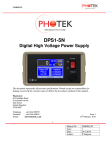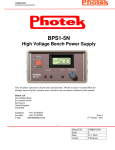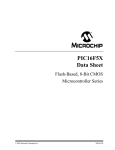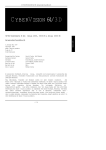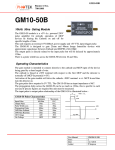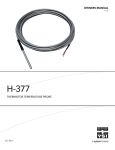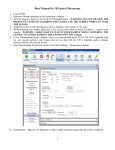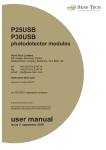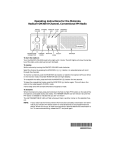Download Image Intensifier User Guide
Transcript
Image Intensifier User Guide This User Manual is intended to provide guidelines for the safe operation of Photek MCP Intensifiers. (Please take particular note of pages 3 and 4). If you require any further details or assistance, please contact Sales or visit: www.photek.co.uk Contents Health and Safety Advice.......................................................................................... 3 High Voltage..............................................................................................................3 X-Ray Radiation .........................................................................................................3 Storage and Handling ............................................................................................... 3 Operation with an External PSU ................................................................................4 Operation with a Wrap-Around or Flat Pack PSU .....................................................4 Image Intensifiers ..................................................................................................... 5 Introduction ...............................................................................................................5 Mode of Operation ....................................................................................................5 Input Windows ..........................................................................................................5 Spectral Sensitivities of various Photocathodes ........................................................6 Photocathodes on Fibre optic ....................................................................................6 Photocathodes on Quartz (Fused Silica) ....................................................................7 Understanding Microchannel Plates .........................................................................8 MCP Pore sizes ..........................................................................................................8 MCP Thickness ...........................................................................................................8 Electrodes and End Spoiling ......................................................................................9 Open Area Ratio ........................................................................................................9 MCP Stack Configurations .......................................................................................10 MCP Resistance and Strip Current ...........................................................................12 Underlays and Meshes ............................................................................................12 Gating ......................................................................................................................13 Gate Units ...............................................................................................................14 Phosphor Screen and Output Window ....................................................................14 Connection Diagrams ..............................................................................................15 Page 1 Illumination Levels ................................................................................................. 18 Single MCP Intensifiers ............................................................................................18 Multi-MCP High-Gain Photon Counting Intensifiers ................................................18 Coupling to other devices ....................................................................................... 19 Glossary of terms ................................................................................................... 19 Contrast Transfer Function (CTF).............................................................................19 Equivalent Background Illumination (EBI) ...............................................................19 First Generation Tubes ............................................................................................20 Gain Terms ..............................................................................................................20 Limiting Resolution ..................................................................................................20 Luminescent Screens ...............................................................................................20 Luminous Sensitivity ................................................................................................21 Modulation Transfer Function (MTF) ......................................................................21 Photocathode ..........................................................................................................21 Photoelectric Gain ...................................................................................................21 Photon Gain.............................................................................................................21 Quantum Efficiency Terms ......................................................................................21 Radiant Sensitivity ...................................................................................................22 Resolution Pattern ...................................................................................................22 Second Generation Tubes ........................................................................................22 Spectral Response ...................................................................................................22 Vision64 ...................................................................................................................22 Page 2 Health and Safety Advice High voltage devices can be hazardous if they are not installed, operated and maintained correctly, or if a device is damaged. Photek cannot accept responsibility for damage or injury resulting from the use of Photek devices. Equipment manufacturers and users should ensure appropriate precautions are taken. Warning labels and notices must be provided on equipment and in operating manuals. High Voltage Equipment must be designed so that operators cannot come into contact with high voltage circuits. Tube enclosures should have fail-safe interlocked switches to disconnect the primary power supply and discharge all high voltage capacitors before allowing access. X-Ray Radiation All high voltage devices produce X-rays during operation and may require shielding. Storage and Handling Avoid storage or operation of image intensifiers at temperatures greater than +40C. Room temperature is preferred (21C). Protect the cathode from intense focused light, sunlight and lasers, even when not running the image intensifier, as this can lead to local thermal overloads and cathode damage. Avoid excessive shock or vibration to the image intensifier as this could damage delicate internal components, such as the MCP. Keep the optics protected from dirt and grease as they could become scratched. Avoid running the image intensifier for long periods of time with a fixed image, especially if it is bright, as there is a possibility that a permanent burnt-in image will occur. Excessive axial force will crack the screen pyroceram material used to seal the output window into the image intensifier body. This renders the tube inoperable. Page 3 Operation with an External PSU If the image intensifier is to be powered by the customer’s own power supply unit, it is important to gradually increase the applied voltage to the required level. It is equally important to gradually reduce and monitor voltages when powering off the image intensifier. IMPORTANT: The maximum voltages are documented in the Test Data Summary and must NEVER be exceeded. The voltage difference between the photocathode and the MCP input must never exceed +/- 200 V unless specified on the Test Data Summary. The brightness of the phosphor screen should be kept below 5 Cd/m 2. Ideally 3 Cd/m2 is required for a typical P20 or P43 phosphor. Customers providing their own power supplies should discuss the suitability of the power supply with Photek Ltd to ensure that it is compatible with the image intensifier being ordered, particularly with respect to insulation, encapsulation earth point etc. Operation with a Wrap-Around or Flat Pack PSU If the image intensifier is supplied with a Wrap-Around or Flat Pack power supply, a +5 V DC supply is required; typical operating current 25-125 mA. Gain is adjustable with a 0-5 V variable DC supply. When switching on, ensure that the image intensifier is in dark conditions. Gradually increase illumination until a glow, or image if using a lens to project an image onto the input optic, is seen at the screen. An optional extra for Wrap-Around or Flat Pack PSUs supplied by Photek is the gain and automatic brightness control (ABC), which ensures a measure of protection from excessive illumination. However, the long term life of intensifiers will be reduced by operation at continuous high light levels. The ABC circuit works by monitoring the screen current. If the screen current approaches the pre-set level, the gain of the intensifier is automatically reduced to maintain the set screen current. It should be noted that the ABC circuit does not protect the tube from damage caused by high focussed light levels over a small area of the detector, as the total screen current may be within the pre-set ABC level. Page 4 Image Intensifiers Introduction Image Intensifiers consist of three basic elements: An input window capable of transmitting light over a particular spectral range that can span from the near UV to near IR with photocathode deposited on its inner surface. One or more microchannel plates (MCPs) to provide electron gain. An output window on which is deposited a suitable luminescent phosphor/aluminium screen. These elements are enclosed in a ceramic and metal housing with suitable leads for electrical connection. Mode of Operation When an image is focused onto the photocathode it emits electrons proportional to the intensity of the incoming light. The electron image is focused onto the MCP, which amplifies the electronic image before it is focused onto the luminescent screen, where the optical image is reproduced. Focusing is by means of the proximity wafer structure. This consists of a planar photocathode, MCP and screen in parallel and very close proximity to each other. Applying suitable high voltages between these electrodes ensures electron transmission, gain and acceleration, giving a non-inverted distortion free image. Input Windows Photek can supply image intensifiers with a range of input windows including: Fibre Optic Glass Fused Silica MgF2 Others on request Typical transmission properties of each of the windows are shown in the graph to the right. Page 5 Spectral Sensitivities of various Photocathodes Image intensifiers having borosilicate glass or fibre optic windows will not operate below the cut-off frequency of these materials, i.e. 300 - 350 nm, despite the fact that the photocathode still has adequate sensitivity in this region. However, Fused Silica, Magnesium Fluoride or Sapphire input windows will extend the spectral response to the limit imposed by the transmission of these materials (180 nm for fused silica, 150 nm for Sapphire and 110 nm for MgF2). Photocathodes on Fibre optic Page 6 Photocathodes on Quartz (Fused Silica) Page 7 Understanding Microchannel Plates A Microchannel Plate (MCP) is an electron multiplier that consists of a thin (typically 0.5 mm) glass plate through which run a very large number of parallel tubular channels typically 3 - 10 µm diameter. A 25 mm diameter MCP contains approximately 1.5 million of these channels, also known as pores, which are set at a small bias angle to the major axis of the MCP to increase the chances of electrons colliding with the channel walls. Electrons entering a channel in the MCP collide with the channel wall and produce secondary electrons. These electrons are accelerated through the channel by means of the high potential gradient applied to the MCP and by further collisions with the channel wall, produce additional secondary electrons at each collision. The result of these repeated collisions is an avalanche of electrons giving an output electron gain of around 103 for a typical single MCP at an applied operating potential of 800 V. MCP Pore sizes The table below shows typical MCPs used in Photek detectors. Smaller pore MCPs are capable of resolving greater detail. Pore Diameter / Pitch (µm) 3.2/4.2 6/8 10/12 25/32 Detector Active Diameter 18 mm 25 mm 40 mm x x x x x x 75 mm 150 mm x x x MCP Thickness The thickness of a MCP is defined by the pore length to diameter (l/d) ratio and is typically in the range 40:1 to 80:1. Gain of a MCP is proportional to its l/d ratio, the secondary emission coefficients of the MCP, the applied voltage and end spoiling. Page 8 Electrodes and End Spoiling During the final stage of manufacturing a MCP, an electrode made from Inconel or Ni-Cr is evaporated onto the input and output faces of the MCP leaving a surface resistance of approximately 100 Ω/square. During evaporation of the output electrode the coating penetrates each pore by a depth of between 0.5 and 3 pore diameters thus removing the secondary emission characteristic from the end of the MCP pore. For high resolution detectors such as image intensifiers, greater end spoiling results in a more collimated electron cloud, producing improved spatial resolution. This can result in lower maximum gain. Open Area Ratio The Open Area Ratio (OAR) is the ratio of the area occupied by the MCP pores to the surface area of the MCP. For hexagonal arrays, OAR = [/ (23)] (d/p)2 where d is the channel diameter and p is the pitch. For example 10/12 MCPs have an OAR of 63 %. However, custom MCPs can be manufactured with higher open area ratios by increasing the hole diameter and keeping the pitch the same. Page 9 MCP Stack Configurations Microchannel plates are typically configured in single, chevron or Z stacks with the latter two being used in MCP2xx and MCP3xx intensifiers. The bias angle is rotated by 180 degrees as each plate is added to the stack, resulting in the chevron and Z stacks. This reduces the chance of optical feedback from the phosphor screen to the photocathode and it enhances secondary emission at the front of the second and third MCPs and can result in improved PHD characteristics. With a single MCP, there is a physical limitation in gain of about 104. With gain values above 104, Ion feedback can occur as the electron shower becomes more intense and this can reduce the life of the detector. By stacking 2 or 3 plates in V or Z stack configuration, Ions generated in the 2nd or 3rd plate cannot travel back to the photocathode as they are blocked in the 180 degree interface between the two MCPs. Photek Image intensifiers are available in a range of different micro channel plate configurations. These include the stack configuration, l/d ratio and the pore/pitch ratio of the microchannel plate. The table on page 12 shows typical configurations. Page 10 MCP1xx Single plate image intensifier Typical MCP Configuration: l/d ratio diameter/pitch (µm) 40:1 55:1 55:1 60:1 10/12 10/12 6/8 4/5 MCP2xx Image Intensifier Typical MCP Configuration: l/d ratio diameter /pitch (µm) 40:1 55:1 55:1 60:1 10/12 10/12 6/8 4/5 MCP3xx Image Intensifier Typical MCP Configuration: l/d ratio diameter /pitch (µm) 40:1 55:1 55:1 60:1 10/12 10/12 6/8 4/5 MCP3xx Image Intensifier Typical MCP Configuration: Front MCP Rear MCP l/d ratio diameter/pitch (µm) 60:1 60:1 10/12 10/12 MCP3xx Image Intensifier Typical MCP Configuration: Front MCP Rear MCP l/d ratio diameter/pitch (µm) 40:1 80:1 10/12 10/12 Page 11 MCP Resistance and Strip Current MCP manufacturers generally specify the strip current at 1000 V, however Photek normally refer to MCP resistance. High Output Technology MCPs (referred to as “HOT”) are much lower in resistance than standard MCPs and have the advantage that their recovery time is much faster. This is particularly important in pulsed or high speed gating applications where local areas of the MCP are repeatedly stimulated. Depending on the resistance of the MCPs, special high voltage power supplies may be required. It should also be noted that low resistance MCPs may not be suitable for applications requiring very low dark noise, particularly in photon counting detectors. Underlays and Meshes Most photocathodes have a relatively high resistance. For gating applications it is necessary to reduce the photocathode resistance and this can be done by applying an underlay or mesh to the input window prior to deposition of the Photocathode. Underlays typically involve evaporating a transparent conducting layer directly onto the input window. Depending on the gating characteristics required, the transmission of the layer will be in the range 50 % to 98 %. A 50 % transmission underlay should allow gating to 5 ns on a 25 mm image intensifier, whereas a 95 % transmission underlay may only achieve 100 ns gating. The disadvantage of thick underlays is that the spectral sensitivity can be significantly reduced depending upon the wavelength of interest. For faster gating performance or where loss of spectral sensitivity cannot be tolerated, a mesh can be photo-etched onto the input window. Standard meshes are 10 µm lines on a 100 µm pitch; however, these can be visible in a flat field image. High resolution meshes with 2 µm lines on a 20 µm pitch have been developed which are almost invisible. Page 12 Gating Most image intensifiers have gating capabilities. This allows the image intensifier to be used as a fast optical switch or shutter. The gating speed is proportional to the RC associated with the gap between the photocathode and MCP, where R is the resistance of the photocathode and C is the capacitance of the gap between the photocathode and MCP. Multi-alkali photocathodes generally have a lower resistance than Bialkali or Solar Blind cathodes. To achieve ultra-fast gating performance, it is necessary to reduce the photocathode resistance by applying a conducting underlay or mesh to the window substrate. The capacitance is proportional to the surface area of the cathode and inversely proportional to the gap between cathode and MCP. Smaller area detectors or detectors with a large cathode to MCP gap will gate faster. The table below outlines typical cathode capacitance and is for guidance only: Active Diameter (mm) 40 40 40 25 25 25 18 18 18 Cathode to MCP Gap (µm) 200 100 50 200 100 50 200 100 50 Ceramic Capacitance (pF) Gap Capacitance (pF) 38 38 38 16 16 16 8 8 8 58 117 234 23 47 94 13 26 52 Page 13 Total Capacitance (pF) 96 155 272 39 63 110 21 34 60 Gate Units Gate Unit Power Supply GM10-50B +5 V GM300-3N +12 V GM300-3P +12 V GM300-8U +12 V *Adjustable transition time Maximum Repetition Rate (kHz) 10 300 300 300 Rise / Fall Time (ns) Minimum Width (ns) Propagation delay (ns) 30 1.5 1.5 5 – 13* 50 3 3 8 110 50 50 35 When considering the table above, it should be noted that the limiting factor of gating performance will almost certainly be defined by the RC time constant of the image intensifier. The GM300-3P and 3N are complimentary units, one being designed just for short “on” windows (3N) while the other is only used for short “off” windows (3P). The GM10-50B and the GM300-8U can be used in either configuration. Phosphor Screen and Output Window The electron image emerging from the MCP output is accelerated into a layer of phosphor deposited on the output window. A thin film aluminium electrode is deposited on the MCP side of the phosphor screen to act as an acceleration electrode for electrons and a naturally reflective membrane for the photons generated within the phosphor screen. Page 14 Connection Diagrams There are many possible combinations of Photek Image Intensifiers, power supplies and gate units. The tables below detail some of the more common configurations: Configuration 1 This is the standard colour wiring convention for a Photek image intensifier. Configuration 2 Where gating is required, the blue wire may be replaced with a coax cable terminated with a SMA connector. The outer conductor of the coax cable is internally connected to MCP Input. Configuration 3 This configuration shows how a standard wired single MCP intensifier is connected to a FP610 power supply. The green ITO wire if fitted, must be connected to ground. Configuration 4 This configuration shows how a single MCP intensifier is wired directly to a FP610 power supply. The ITO connection if required, is connected internally. Configuration 5 This configuration shows how a standard wired multi MCP intensifier is connected to a FP630 power supply. The green ITO wire if fitted, must be connected to ground. Page 15 Configuration 6 This configuration shows how a multi MCP intensifier is wired directly to a FP630 power supply. The ITO connection, if required, is connected internally. Configuration 7 This configuration shows how a standard wired single MCP intensifier is connected to a FP610 power supply. The cathode wire is fitted with a coax cable and terminated with a SMA connector. This then connects to the gate unit. Configuration 8 This configuration shows how a single MCP intensifier is wired directly to a FP610 power supply. The ITO connection if required, is connected internally. The cathode wire is fitted with a coax cable and terminated with a SMA connector. This then connects to the gate unit. Configuration 9 This configuration shows how multi MCP intensifier is wired directly to a FP630 power supply. The ITO connection, if required, is connected internally. The cathode wire is fitted with a coax cable and terminated with a SMA connector. This then connects to the gate unit. Configuration 10 This configuration shows how a standard wired multi MCP intensifier is connected to a FP630 power supply. The cathode wire is fitted with a coax cable and terminated with a SMA connector. This then connects to the gate unit. Page 16 Configuration 11 For image intensifiers supplied with a Wrap Around power supply, +5 V power, 0 V and 0 to 5 V gain adjustment connections are required. Configuration 12 For image intensifiers supplied with a Wrap Around power supply and internal GM10-50 gate unit, +5 V power, 0 V and 0 to 5 V gain adjustment, and TTL trigger connections are required. Configuration 13 For image intensifiers supplied with a gated Wrap Around power supply, +5 V power, 0 V and 0 to 5 V gain adjustment, and TTL trigger connections are required. Page 17 Illumination Levels In considering maximum input light levels, it is important to remember that the life of an intensifier is directly dependent on illumination levels while it is operating. The Wrap-Around PSU, supplied by Photek, has a photocathode current limiting resistor of approximately 2 GΩ, which provides bright source protection (BSP). An automatic brightness control (ABC) may also be incorporated in the PSU in order to limit the output brightness. This is achieved by controlling the gain of the intensifier at varying input levels. This offers some protection not only for the intensifier but for any light sensitive device coupled to the output screen of the image intensifier. Typical operating illumination levels depend upon cathode spectral response and the number of channel plates used in the image intensifier. Single MCP Intensifiers With an S25 photocathode, the optimum operating conditions are in the range 10 -5 to 10-4 lux (10-6 to 10-5 foot-candles). This is equivalent to a photocurrent of around 2 pA. The spectral response curve supplied with the tube can be used to calculate radiant input, in terms of watts or photons/second for specific wavelengths to give a suitable photocurrent of about 2 pA. Image intensifiers supplied by Photek can be calibrated in terms of luminous gain and/or radiant gain at wavelengths specified by the customer. Multi-MCP High-Gain Photon Counting Intensifiers As the light level is reduced, the image gets weaker and harder to see. The temptation is to specify a tube with higher gain. However, this will not always solve the problem, which is more about the small number of photons available to produce an image within the integration time of the eye or electronic readout. Improved performance can be achieved by frame averaging or electronic integration. Multi MCP tubes are often recommended in conjunction with fast phosphors, for example P46 and P47, to overcome the low luminous efficiencies. In this case, the recommended input illumination levels are similar to those given for single MCP tubes. Double and triple MCP stages produce a peaked pulse height distribution, enabling the user to set electronic thresholds to distinguish between camera noise and photon events. In these applications, input fluxes should be in the order of a thousand photons per second per cm2, 10-13 W/cm2, 10-8 lux or 10-9 foot-candles. This in human terms is not visible to the eye. Page 18 Coupling to other devices When coupling other devices to the screen, three factors should be considered: Avoid applying excessive pressure to the screen optic of the intensifier. To do so could crack the fibre optic seal and cause the tube to leak to atmospheric pressure, rendering it useless. Charging effects can occur when optics are directly coupled to each other. To avoid this, the intensifier can be supplied with a conducting coating (ITO) on the outside surface of the screen optic. This can then be connected to a grounded wire which eliminates static charge effects. Some devices coupled to the image intensifier may require the intensifier to operate with a higher than recommended screen brightness. The level of brightness should be kept to a minimum in order to maintain a linear dynamic amplification range. The life of an image intensifier will be reduced if operating continuously at an output brightness of greater than 5 Cd/m2. Photek recommends a screen output brightness of 3 Cd/m2 for a P20 phosphor. The output brightness of an image intensifier is also related to anode current. This factor should be considered when using image intensifiers that have screen phosphors with a lower efficiency than a P20 phosphor. Glossary of terms Contrast Transfer Function (CTF) The CTF is the square wave spatial-frequency amplitude response and is frequently quoted as it is easier to measure than MTF. Either form of response can be converted to the other. Equivalent Background Illumination (EBI) The screen of an intensifier will have an inherent finite brightness when the supply voltage is applied and there is no incident light on the photocathode. The EBI is the input illumination required to give an increase in screen brightness equal to this background brightness. Page 19 First Generation Tubes Tubes in which the primary photoelectrons are accelerated by a high electric field to energies of around 25 keV and electrostatically focused onto a phosphor screen. The energy gained by the electrons in the field is released as a flash of light in the phosphor screen. With modern screens, several hundred photons may be released by each electron impact. Gain Terms The gain is usually defined in two ways related to photocathode spectral response. Luminous Gain The ratio of the phosphor screen luminous emittance (Cd/m2) to the illuminance incident on the photocathode (lux) at a colour temperature of 2856 K. Radiant Gain The ratio of the phosphor screen radiant emittance in W/m2 to the irradiance on the photocathode in W/m2. Limiting Resolution A measure of the ability to discern image detail by focusing a black and white resolution pattern onto the photocathode. The spatial frequency value at 5 % MTF is taken to be the limiting resolution and is expressed in lp/mm. Luminescent Screens The choice of phosphor deposited on the output window is determined by two main considerations: Required Spectral Range For example, in applications where the screen is to be viewed directly by the naked eye, a yellow-green phosphor, with peak radiant energy at around 550 nm is typically used. Alternatively, for photographic applications, a blue phosphor such as P11, having a spectral output peaking at around 400 nm, is generally more suitable. Persistence A short persistence phosphor is necessary to evaluate rapidly occurring events, whereas a longer persistence phosphor is of benefit where image luminance is fluctuating and needs to be integrated. Page 20 Luminous Sensitivity The responsivity of a photocathode to luminous energy in the form of a light source at a colour temperature of 2856 K. It is the ratio of photoelectric emission to incident luminous flux expressed in microamperes per lumen (µA/lm). Modulation Transfer Function (MTF) A graph describing the modulation of the image of a sinusoidal object as the frequency increases. In measuring resolution, as the line width and spacing are reduced, there is a limit beyond which the contrast of the black and white line pattern cannot be lowered without the pattern becoming indecipherable. The relationship between this contrast modulation, expressed as a percentage and the number of line-pairs is referred to as the MTF. It is usually specified as a percentage at a particular number of line-pairs per millimetre (lp/mm). Photocathode A photoelectric material, which emits electrons when, irradiated with photons. Varying spectral response characteristics can be obtained by a combination of appropriate photocathode and input window material. Photoelectric Gain Photoelectric gain is the number of photons out per photoelectron. Photon Gain Photon gain is the number of photons out per photon in i.e. a function of wavelength because of photocathode efficiency so: PHOTON GAIN = DQE x PHOTOELECTRON GAIN. Quantum Efficiency Terms Quantum efficiency (QE) is the ratio of the number of emitted photoelectrons to the number of incident photons usually expressed as a percentage at a particular wavelength. QE can be calculated at any given wavelength from the formula QE 124 S Where S (λ) is the cathode radiant sensitivity in mA/W at wavelength λ in nm. Page 21 It is important to distinguish between the responsive quantum efficiency (RQE) and the detective quantum efficiency (DQE). RQE is the fraction of input photons that give rise to primary electrons, and DQE is the fraction of input photons that give rise to discrete output events. In MCP devices the DQE is approximately 50 - 60 % of the RQE due mainly to the effect of the open-area-ratio of the MCP. In a proximity diode, however, the DQE is around 85 % of the RQE, the difference being due only to absorption of electrons by the aluminium backing of the phosphor screen. Radiant Sensitivity Radiant Sensitivity is the responsivity of a photocathode to monochromatic light expressed in milliamps per watt (mA/W) at the prescribed wavelength. Resolution Pattern A pattern comprising a series of sets of lines at progressively smaller line widths and spacings that is used to determine the number of lines per millimetre that an optical system is capable of resolving or separating clearly. For modulation transfer function (MTF) measurements, the pattern must have lines with a sine wave distribution of brightness. Second Generation Tubes Here the primary photoelectrons are multiplied by an MCP which is placed in close proximity to both the photocathode and the phosphor screen, therefore preserving the spatial coherence of the electron image. The electron multiplication enables far greater intensification to be achieved than in first generation devices - up to hundreds of thousands of photons being released by the screen for each primary electron entering the MCP. Spectral Response The Spectral Response is the variation of sensitivity with wavelength in an input window and photocathode combination. The materials used and the stoichiometry of the photocathode have a great bearing on spectral response. Vision64 Photek’s proprietary software is used for the testing and evaluation of Image Intensifiers. This software is also available to purchase. Page 22 Notes: Photek Limited 26 Castleham Road, St Leonards on Sea, East Sussex, TN38 9NS United Kingdom. Page 23 Tel: +44 (0)1424 850555 Fax: +44 (0)1424 850051 [email protected] www.Photek.co.uk Document Issue Date UM006 01 July 2015


























